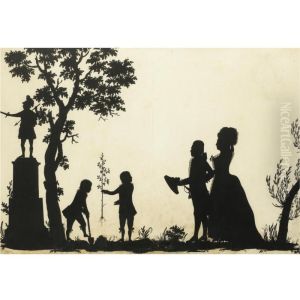Johann Friedrich Anthing Paintings
Johann Friedrich Anthing was a German artist, engraver, and miniaturist who was born in Gotha, Germany, in 1753. He was active during the late 18th century, a period that was characterized by significant developments in the arts, including the neoclassical movement, which influenced Anthing's work. His life spanned an era of considerable change in Europe, including the Enlightenment and the French Revolution, which had a profound impact on the cultural and political landscapes of the time.
Anthing showed an early talent for art and pursued his artistic training with dedication. His skills in engraving and miniature painting were honed through practice and study. He became known for his fine detail work and his ability to capture the likeness and character of his subjects. His miniatures often served as personal keepsakes and were highly valued for their intimate scale and the precision with which they were executed.
During his career, Anthing traveled extensively throughout Europe, which was common for artists of his time, as they sought patronage and new influences. He spent time in various German states, as well as in Russia, where he worked for a period at the court of Tsarina Catherine the Great. His time in Russia and his exposure to the imperial court there likely provided him with opportunities to refine his technique and to produce works for a prestigious clientele.
Despite his talent and the quality of his work, detailed documentation about Anthing's life and career remains limited. The records of his patronage and the specific pieces he produced are not as extensive as those of some of his contemporaries. However, the works that do survive attest to his skill and the esteem in which he was held during his lifetime.
Johann Friedrich Anthing died in 1805. While he may not be as widely recognized today as some other artists of his era, his contributions to the art of miniature painting and engraving provide valuable insight into the aesthetic sensibilities and the technical accomplishments of the late 18th century. His surviving works continue to be appreciated by collectors and art historians for their elegance and craftsmanship.
